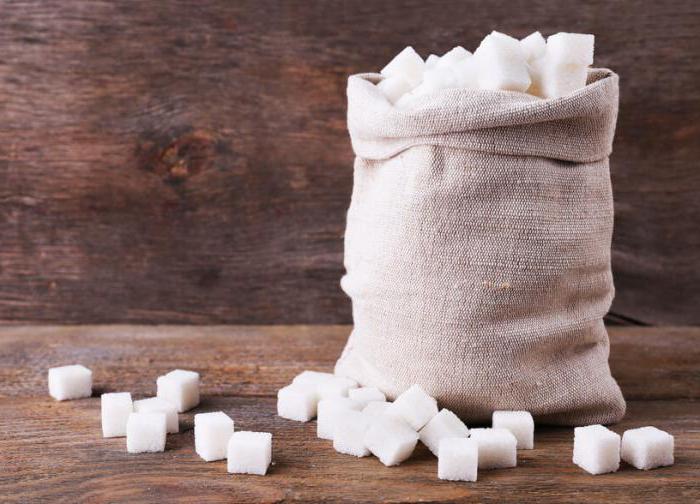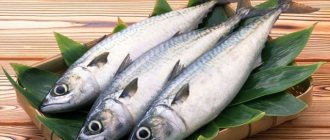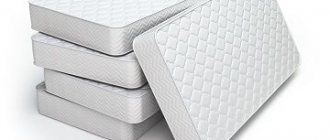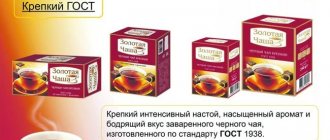According to GOST
A number of standards have been adopted at the state level regulating the quality and shelf life of the product:
- GOST 33222-2015 “White sugar. Technical Specifications" contains requirements for organoleptic properties, raw materials, packaging, and labeling.
- GOST 21-94 “Granulated sugar” has become invalid.
- GOST 26907-86 “Sugar. Long-term storage conditions” lists what requirements are imposed on the environment to preserve the quality of the product.
- GOST R 54902-2012 “Raw cane sugar molasses. Technical Specifications" contains information on what type of cane product should be.
GOST 33222-2015. Interstate standard. Sugar is white. Specifications
4. Technical requirements
4.1 Characteristics
4.1.1 White sugar must comply with the requirements of this standard and be manufactured according to technological instructions in accordance with [1].
4.1.2 Depending on the type of raw material used, white sugar is distinguished:
– beet;
– from raw cane sugar.
4.1.3 Depending on the production method, white sugar is divided into:
– crystalline;
– lump;
- powdered sugar.
4.1.4 Crystalline white sugar is produced with crystal sizes from 0.2 to 2.5 mm inclusive. The presence of crystals with deviations from the lower and upper limits of the specified sizes of no more than 5% of the mass of the analyzed white sugar sample is allowed - according to GOST 12579.
Crystalline white sugar, depending on the fraction, can be produced as:
– fine-crystalline;
– coarse-crystalline.
Coarse-crystalline white sugar is produced with crystal sizes from 2.0 mm. The deviation of crystal sizes from the specified value downwards is allowed by no more than 15% of the mass of the analyzed white sugar sample - according to GOST 12579.
Fine-crystalline white sugar is produced with crystal sizes up to 0.5 mm inclusive. The maximum deviation of crystal sizes from the specified value is allowed by no more than 10% of the mass of the analyzed white sugar sample - according to GOST 12579.
4.1.5 White lump sugar is made into individual pieces of specific shapes and sizes by pressing crystalline sugar.
4.1.6 Powdered sugar is made by grinding white sugar crystals to a size of not more than 0.2 mm, with or without the addition of anti-caking agents. The maximum deviation of crystal sizes from the specified value is allowed by no more than 5% of the mass of the analyzed white sugar sample - according to GOST 12579.
4.1.7 Depending on quality indicators, white sugar is divided into four categories: extra, TC1, TC2, TC3.
4.1.8 In terms of organoleptic indicators, white sugar must meet the requirements specified in Table 1.
Table 1
| Indicator name | Characteristics of white sugar | ||
| Crystal sugar | Powdered sugar | Lump sugar | |
| Color | White, clean. For sugar category TC3, a yellowish tint is allowed | White, clean, no stains | |
| Appearance | Homogeneous free-flowing mass of crystals. For sugar categories TC2 and TC3, lumps that fall apart when lightly pressed are allowed. | Homogeneous free-flowing mass of crushed crystals | In the form of pieces of a certain shape and size without foreign inclusions |
| Smell and taste | Characteristic of sugar, sweet, without foreign smell and taste both in dry sugar and in its aqueous solution. For sugar category TC3, a slight odor of molasses is allowed | ||
| Purity of the solution | The sugar solution must be transparent, without insoluble sediment, mechanical and other impurities. For sugar of categories TC2 and TC3, opalescence is allowed. For powdered sugar, the purity of the solution is not determined. | ||
4.1.9 In terms of physical and chemical indicators, white sugar must comply with the standards specified in Table 2.
table 2
| Indicator name | Value by category of crystalline white sugar, non-caking powdered sugar, lump white sugar | |||
| Extra | TS1 | TS2 | TS3 | |
| Mass fraction of sucrose by direct polarization, %, not less | ||||
| – crystal sugar | 99,80 | 99,70 | 99,70 | 99,50 |
| Mass fraction of moisture, %, no more than: – crystalline sugar1 | 0,10 | 0,10 | 0,12 | 0,15 |
| – powdered sugar without anti-caking agents | 0,20 | 0,20 | 0,20 | — |
| - lump sugar | 0,25 | 0,25 | 0,25 | 0,25 |
| Mass fraction of reducing substances (in terms of dry matter), %, no more | 0,03 | 0,035 | 0,04 | 0,065 |
| Mass fraction of ash (in terms of dry matter), %, no more | 0,027 | 0,036 | 0,036 | 0,050 |
| Color in solution, optical density units (ICUMSA), no more | 45,0 | 60,0 | 104,0 | 195,0 |
| Strength of lump white sugar according to Bonvech, MPa, not less | 1,5 | 1,5 | 1,5 | 1,5 |
| Duration of dissolution of lump white sugar in water2, min, up to | 6 incl. | 6 incl. | 6 incl. | 6 incl. |
| Mass fraction of fines (shards weighing less than 25% of the mass of the piece, crystals and crushed crystals) in the package of white lump sugar, %, no more | 2,0 | 2,0 | 2,0 | 2,0 |
| 1For sugar sent for storage in bulk warehouses, the mass fraction of moisture is no more than 0.06%. 2The duration of dissolution of white lump sugar in water is determined in the absence of a Bonvecha press. | ||||
4.1.10 Physico-chemical parameters of powdered sugar with the addition of starch as an anti-caking agent are given in Appendix A.
4.1.11 Microbiological indicators of white sugar for the production of baby food products, canned milk with sugar, as well as for the biopharmaceutical industry should not exceed the standards established [1].
4.1.12 The content of toxic elements and pesticides in white sugar should not exceed the permissible levels established [1].
4.1.13 The content of ferroimpurities and sulfur dioxide should not exceed the standards established in Table 3.
Table 3
| Indicator name | Acceptable level |
| Mass fraction of sulfur dioxide, mg/kg sugar, no more | 15 |
| Mass fraction of ferroimpurities1,%, no more | 0,0003 |
| 1The size of individual particles of ferroimpurities should not exceed 0.3 mm in the largest linear dimension. | |
4.1.14 Additional requirements for the quality of white sugar may be determined by contract with the purchaser.
4.2 Requirements for raw materials
4.2.1 The following raw materials are used for the production of crystalline white sugar:
– sugar beets in accordance with GOST 174211 and (or) sugar syrup stored for storage after an evaporation unit with a dry matter content of at least 65% and a pH of at least 7.0;
1In the Russian Federation, GOST R 52647-2006 “Sugar beets. Technical conditions" and GOST R 53036-2008 "Sugar beets. Test methods".
– raw cane sugar1 and (or) sugar syrup after defecation purification, filtration and thickening of raw sugar clarification with a dry matter content of at least 65% and a pH of at least 7.0;
– sugar syrup obtained after desugarification of molasses, according to the manufacturer’s technical document.
1In the Russian Federation, GOST R 52305-2005 “Raw sugar. Technical conditions".
4.2.2 For the production of lump sugar, crystalline white sugar of the categories extra, TC1, TC2, TC3 is used; for the production of powdered sugar, crystalline white sugar of the categories extra, TC1, TC2 is used.
To prevent clumping of powdered sugar, anti-caking agents are introduced into its composition: corn starch according to GOST 32159 - up to 5%; tricalcium phosphate, magnesium carbonate, silicon dioxide, calcium silicate, magnesium trisilicate, meeting the requirements of [4] or regulatory legal documents in force in the territory of the state that has adopted the standard.
The maximum level of anti-caking agents is 1.5%, alone or in combination.
4.3 Packaging
4.3.1 All types of packaging must ensure the safety of white sugar during its transportation and storage [2].
4.3.2 White sugar for sale in the retail trade network is packaged in consumer packaging (boxes in accordance with GOST 12301, packs in accordance with GOST 12303, bags, sachets) or other packaging of equivalent quality in terms of quality, made from materials that ensure the strength of the packaging and the use of which in contact with the product of this type ensures its quality and safety in accordance with [2].
4.3.3 White sugar is packaged with a nominal weight:
– in bags from 5.0 to 20.0 g inclusive – crystal sugar, powdered sugar, lump sugar;
– packages from 0.10 to 5.0 kg inclusive – crystal sugar, powdered sugar;
– boxes, packs, bags from 0.25 to 1.0 kg inclusive – lump sugar.
It is allowed to pack white sugar in consumer packaging with other nominal weights of white sugar.
4.3.4 The sachets are packaged in packs in accordance with GOST 12303 and boxes in accordance with GOST 12301 or other packaging of equivalent quality in terms of quality, made from materials that ensure the strength of the packaging and the use of which in contact with a product of this type ensures its quality and safety in accordance with [2].
4.3.5 Consumer packaging made of paper is sealed with polyvinyl acetate dispersion in accordance with GOST 18992 or other glue, which ensures the integrity of the packaging and is approved for use by the authorities exercising control functions in the field of ensuring the sanitary and epidemiological well-being of the population in the territory of the state that has adopted the standard.
Consumer packaging made from polymer materials is heat sealed.
4.3.6 White sugar in consumer packaging is packaged in transport packaging that ensures strength and safety in accordance with [2]:
– boxes made of corrugated cardboard in accordance with GOST 13511 or GOST 13512 from materials that ensure the strength of the packaging;
– group packaging made of shrink film according to GOST 25951;
– group packaging of two layers of paper with a mass of 1 m2 of at least 100 g or in another package of equivalent quality in terms of quality.
Corrugated cardboard boxes are covered with paper tape in accordance with GOST 10459, or with paper-based adhesive tape in accordance with GOST 18251, or with polyethylene tape with an adhesive layer in accordance with GOST 20477. It is allowed to use another tape for gluing with equivalent quality indicators, ensuring the strength of the closure of a corrugated cardboard box.
Group packaging made of paper is cross-tied with twine in accordance with GOST 17308 or glued together by machine.
4.3.7 White sugar is packaged in transport packaging (bags in accordance with GOST 30090, GOST 32522 or other bags of equivalent quality, polypropylene bags with plastic liners in accordance with GOST 19360, soft specialized containers for bulk products in accordance with regulatory documents of the state that has adopted the standard) or other types of packaging made from materials that ensure the strength of the packaging and the use of which in contact with a product of this type ensures its quality and safety in accordance with [2].
4.3.8 White sugar is packaged in transport packaging with a nominal weight:
– in bags of 50 kg – crystalline sugar;
– in 40 kg bags – powdered sugar;
– in soft containers up to 1 t – crystalline sugar, powdered sugar.
It is allowed to pack white sugar in transport packaging with a nominal weight of 5, 10, 25 kg or another nominal weight.
4.3.9 Bags of white sugar are sewn up by machine with threads: linen according to GOST 14961, cotton or synthetic according to GOST 6309 or other threads that provide mechanical strength to the sewing along the entire width of the bag.
4.3.10 By agreement with the purchaser, it is allowed to supply white sugar in bulk in sugar trucks and (or) railway grain hoppers adapted for the transportation of crystalline white sugar, which must be sealed after loading.
4.3.11 Requirements for the amount of sugar contained in packaging units, for the negative deviation of the actual mass of packaged white sugar in a consumer packaging unit from the nominal mass - according to GOST 8.579-2002.
The limits of permissible positive deviations of the actual weight of packaged white sugar in a packaging unit from the nominal weight are established by the manufacturer in the technological documentation.
4.4 Marking
4.4.1 Labeling of consumer packaging
4.4.1.1 Labeling of consumer packaging with sugar - in accordance with the requirements established [3].
4.4.1.2 Each unit of consumer packaging (boxes, packs, bags) can be artistically designed and must contain the following information:
– name and category of sugar;
– origin by type of raw material (beet or raw cane sugar);
– name and location (legal address, including country) of the manufacturer;
– manufacturer’s trademark (if available);
– bar coding;
– sulfur dioxide content when the content exceeds 10 mg/kg;
– nominal weight of the packaging unit;
– nutritional and energy value;
– year of manufacture and date of packaging;
– name and quantity of added anti-caking agent (for powdered sugar);
– shelf life and storage conditions;
– designation of this standard;
– information on confirmation of conformity.
Information on the nutritional and energy value of 100 g of white sugar is given in Appendix B.
The origin of sugar by type of raw material is determined by the manufacturer based on the actual type of processed raw material.
4.4.1.3 The inscriptions are printed directly on the consumer packaging.
The ink used for printing should not penetrate the packaging and impart an off-flavor or odor to the white sugar.
4.4.1.4 The following information is indicated on white sugar packets with a nominal weight of 5 to 20 g:
– name and trademark (if any) of the manufacturer;
– name of white sugar;
– nominal mass, g;
– designation of this standard.
4.4.2 Labeling of transport packaging
4.4.2.1 Each unit of transport packaging must be marked, which is applied directly to the surface or to a label measuring at least 100 x 60 mm.
The label is made from materials that ensure its strength and are approved for use in the prescribed manner. A label with markings is sewn simultaneously with sewing up the bag, or glued to the surface of the transport container, or placed in a special pocket of a soft container.
The ink used for printing should not penetrate the packaging and impart an off-flavor or odor to the white sugar.
4.4.2.2 The marking of the transport package must contain the following information:
– name and category of sugar;
– origin by type of raw material (beet or raw cane sugar);
– name and location (legal address, including country) of the manufacturer;
– manufacturer’s trademark (if available);
– nominal weight, gross weight;
– number of packaging units and nominal weight of the packaging unit;
– nutritional and energy value;
- Year of manufacture;
– sulfur dioxide content when the content exceeds 10 mg/kg;
– shelf life and storage conditions;
– name and quantity of added anti-caking agent (for powdered sugar);
– bar coding (if available);
– designation of this standard;
– information on confirmation of conformity.
Information on the nutritional and energy value of 100 g of white sugar is given in Appendix B.
4.4.2.3 Marking of transport packaging (bag, box, soft container, group packaging made of paper) is carried out in accordance with the requirements established [3], with the application of the handling sign “Keep away from moisture” in accordance with GOST 14192.
4.4.2.4 It is allowed to include additional information in the marking, determined by the contract with the purchaser.
Marking
The marking is applied to the packaging and contains:
Dear readers! To solve your problem right now, get a free consultation
— contact the lawyer on duty in the online chat on the right or call: +7 (499) 938 6124 — Moscow and region.
+7 (812) 425 6761 — St. Petersburg and region. 8 (800) 350 8362 - Other regions of the Russian Federation You will not need to waste your time and nerves
- an experienced lawyer will solve all your problems!
- Name;
- manufacturer;
- country of origin;
- weight;
- the nutritional value;
- the regulatory act in accordance with which it was manufactured;
- raw materials: SV - beet, SC - cane;
- date of manufacture.
Is he there?
Although the product is not a perishable product, sugar still has an expiration date. Moreover, this period is directly indicated by the state standard.
Subject to strict environmental parameters, it lasts up to 8 years. If in winter it is stored in an unheated room, then it is significantly reduced: a maximum of 5 years for refined sugar, up to 4 years for sand, 2 years without containers.
The raw materials from which the product is made are not decisive. The active ingredient that imparts sweetness in all varieties is sucrose, so the period of preservation of the properties is identical.
Storage conditions, containers, and environmental parameters come to the fore. It will depend on them whether the sand will retain its properties until the end of its shelf life.
How long do different types of sugar last?
There are different types of sugar depending on the raw materials. These are familiar products made from sugar beets and sugar cane. There are also exotic varieties:
- maple;
- sorghum;
- palm;
- coconut.
The main component of all these types is the same - sucrose, so the storage conditions and periods are identical.
Note to the hostess
The shelf life of vanilla sugar is different, because it contains vanilla, and it cannot be stored for more than a year. Therefore, this mixture must be consumed within 12 months from the date of manufacture.
Timing and types
| Variety | Shelf life (years) | ||||
| Glass | Plastic | Metal | Bag | Stick | |
| Crystal | 4-8 | 4-8 | — | 4-8 | 4 |
| Refined sugar | 8 | 8 | — | 8 | — |
| Vanilla | 1 | 1 | — | 1 | 4 |
| Reed | 8 | 8 | — | 8 | 4 |
| Brown | 8 | 8 | — | 8 | 4 |
There are many varieties, the basis of division is the raw material or form.
Crystalline (granular) – these are crystals of different fractions. They are used for baking, decorating confectionery products, and are made from cane or beets.
Refined sugar is a product that has undergone additional purification and is close to pure sucrose. This simultaneously sharpens the sense of taste and is harmful to health, as it causes too sharp a spike in insulin. It is usually shaped into cubes.
Vanilla, in addition to sweetness, gives baked goods a pleasant aroma. Made from sugar and powder of the same name. Vanillin is an artificial substitute for natural vanilla, which can cause an allergic reaction and harm health. Therefore, it is recommended to use a natural analogue by adding it to confectionery products.
Reed is considered the most useful. It is obtained from sugar cane juice. The special color and properties depend on the remaining molasses substance. Contains a range of useful elements and vitamins. Due to the complexity of manufacturing, it costs much more than usual.
Brown is most often produced from cane, since unrefined beetroot has an unpresentable appearance, smell, and taste. Therefore, the brown sugar on store shelves is unprocessed cane sugar.
If you compare the properties of the regular and brown varieties, you can see that they are almost the same in terms of calorie content. They differ only in the content of vitamins, microelements, and the degree of processing. From this point of view, reed wins, but its price is several times higher than the cost of white.
Sugar retains its properties for several years and even after this time remains sweet. The only thing that can happen is clumping, impregnation with unpleasant odors from the surrounding air, and the acquisition of an unusual taste.
Storage
The optimal conditions for storing sugar are heated pantries and other rooms with low humidity levels.
It is important to remember that sugar should not be stored near products with a strong odor and containers with household chemicals, especially if it is in unsealed packaging. This product quickly absorbs environmental odors.
Storing sugar in a plastic bag can normally occur on the shelf of a kitchen cabinet, among pasta and other products without a specific smell.
Storage in bags
Sugar should be stored in bags at a constant temperature (preferably room temperature), in humidity conditions of 70%, and away from sources of strong odors. It is recommended to shake the bag periodically.
Storing Brown Sugar
Brown sugar is not as widely used as white sugar, but according to many researchers, it is more beneficial than beet sugar for the human body.
The reed product has different degrees of purity and crystal sizes.
Cane sugar is most efficiently stored in tightly closed containers (plastic containers, glass containers, zip bags), which can be kept on the shelf of the refrigerator or kitchen cabinet. Before use, a product that has been in a cold place should be warmed to room temperature.
Before storing cane sugar, so that it does not stick together into a lump, put tangerine peels or a piece of bread into the bag.
Storage conditions for granulated sugar
If the product is stored in large quantities, it is necessary to strictly monitor compliance with environmental conditions:
- Humidity should be limited to 70% for packaged silos, 60% for bulk silos, 75% for refined sugar.
- Temperature 20...22 °C for silos, 11...25 - heated warehouses.
- Storage should be carried out on pallets covered with fabric, tarpaulin, or bags. They will absorb excess moisture.
- The bulk product is packaged in bags weighing 10–50 kg and stacked.
- Silos must be insulated to protect them from getting wet.
IMPORTANT! It is contraindicated to store sugar together with other products, as it easily absorbs odors.
Keeping a home doesn't mean it's difficult. The main thing is to avoid humidity and maintain room temperature. If you follow these rules, the period of use can be extended for an indefinite period of time.
When there is a lot of sugar, you need to place it in a cloth bag. If you plan to use it within the next year, you can use a plastic bag. It should be located in a closed cabinet away from heat sources and odorous products.
ADVICE! If you use a plastic bag for storage for more than a year, the product will acquire an unpleasant odor due to lack of ventilation.
In addition, any container made of plastic, ceramics, or glass is suitable. Refined sugar can be left in its original cardboard packaging.
If the product is slightly damp, you can try to correct the situation. To do this, you need to place a container of rice on top of the bag, which will absorb excess moisture.
How is it stored in factories and warehouses?
Sugar storage in warehouses and enterprises must be carried out in accordance with strict rules established by GOST:
- Relative air humidity is no more than 70% for granulated sugar in containers and no more than 60% when storing the product in bulk silos. No more than 75% for refined sugar.
- Recommended storage temperature is from +20 to +22°C in silos, not lower than +11 and not higher than +25°C for heated warehouses.
- When storing the product for a long time, it should be placed on pallets covered with tarpaulin, burlap or other materials that prevent contamination and moisture.
- Granulated sugar and refined sugar are packed in fabric bags or bags made of combined materials, the package weight is 50 kg.
- It is not recommended to store sugar together with other products , as sugar is susceptible to odors.
- Sugar in containers is placed in stacks, limited in height and number of bags (46 for granulated sugar, 36 for refined sugar, etc.). Each stack must consist of homogeneous sugar in the same container, each stack has a stack label with the specified characteristics of the product.
- The outer walls of silos are thermally insulated to prevent product moisture.
You will find recommendations for storing milk on our website.
How to find out if something has gone bad
Over time, changes in sugar may occur:
- dampening due to humidity;
- acquisition of foreign odors;
- unpleasant taste when kept in an unventilated room or container.
The following signs will indicate a delay:
- change in color, smell, taste;
- lumpyness.
Is it possible to use the delay
You should not expect global harm to the body from consuming sugar that has expired. But the pleasant taste sensations from consumption will be spoiled.
However, it is perfect for use at home: canning compotes, jam, making fermentation products, sugar syrup. Its acquired unusual smell and taste are neutralized, and treatment at high temperatures will completely protect it.
House maintenance rules
At home, you should also consider the shelf life of granulated sugar. Products should not be moistened or exposed to low temperatures. If the storage rules are followed, the product retains its properties for the stated period or more.

If you plan on long-term storage, it is best to choose a fabric bag that will protect from moisture. If the product will be stored for up to 1 year, it is advisable to place it in a plastic bag, since long-term storage may cause an unpleasant odor.
Containers made of plastic, tin, ceramics, glass and other materials are excellent for storage. It is advisable to leave refined sugar in cardboard packaging.










